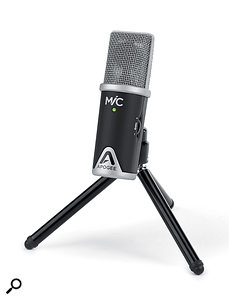The number of direct USB-connected mics seems to be growing daily, and there are obviously many situations where the convenience and immediacy of this approach is paramount. One of the latest additions to this field is Apogee's MiC which, as with all current Apogee products, only works with Mac OS- and iOS-based devices — so if you live in an Apple-free zone you can turn the page right now! MiC is compatible with the iPad (all three versions), iPhone (4 and 4S) and iPod touch on iOS 4.3 or later, or any Mac computer with OS 10.6.4 or later, and it's designed to work with GarageBand and other audio recording apps (I mostly used iRecorder Pro).
 The Apogee MiC with its supplied tripod.Metal-bodied and pretty compact, the MiC measures just 115mm long by 37mm in diameter and weighs 195 grams. The front is styled to resemble a miniaturised studio capacitor mic, but the rear is slightly flattened giving a D-profile when viewed from above. The flat back enables the supplied miniature tripod to be attached via a threaded socket at the rear, and a ball-head allows the angle of the MiC to be adjusted. With the tripod legs opened right out to their maximum angle to ensure stability, the mic capsule ends up roughly 140mm above the table surface.
The Apogee MiC with its supplied tripod.Metal-bodied and pretty compact, the MiC measures just 115mm long by 37mm in diameter and weighs 195 grams. The front is styled to resemble a miniaturised studio capacitor mic, but the rear is slightly flattened giving a D-profile when viewed from above. The flat back enables the supplied miniature tripod to be attached via a threaded socket at the rear, and a ball-head allows the angle of the MiC to be adjusted. With the tripod legs opened right out to their maximum angle to ensure stability, the mic capsule ends up roughly 140mm above the table surface.
The fixed cardioid-pattern capsule appears to be a 15mm electret (ie. typical small diaphragm sized), which is protected behind a multi-layer mesh grille. Its internal 'studio-quality' mic preamp (with a thumbwheel to adjust gain over a 40dB range) is bus-powered from whatever the MiC is plugged into, and digital conversion is courtesy of a 'PureDIGITAL' 24-bit converter and USB encoder which operates at either 44.1 or 48 kHz sample rates (determined by the recording app). The quality of preamp and converter seem to be significantly better than those built-in to iOS devices and Mac sound cards.
A multi-colour LED on the front of the MiC indicates power (blue), an active connection to an audio program (green), and overload (yellow/red). No drivers are required to use the MiC — it's a simple plug-and-play operation with iOS and OS X devices. Two cables are supplied in the box: a 1m cable terminating in a standard USB 2 plug for connecting to Macs, and a 0.5m cable with an iOS Dock connector for the iPad, iPhone and iPod touch. At the other end of these cables is a neat latching connector that slots into the base of the MiC. (Optional extras include three-metre versions of both of these cables, a threaded adapter to allow the MiC to be supported from a standard mic stand, and a protective carrying case.)
After plugging the MiC in, placing it in front of a source, and adjusting the gain, it's just a case of starting recording. The dim blue LED turns green when the recording app is started, and the strength of the green LED is dependent on the recording level. It's just a case of rolling the thumbwheel to get a fairly steady bright green. If it starts to flick orange or red the level is too high.
Recordings made with the MiC sound pleasantly bright, crisp and clean, with negligible electronic noise. It tends to sound a little bass-light unless you work it really close, but actually that's no bad thing for a desktop mic as it aids the clarity of spoken and singing voices, acoustic guitars and so on. I was impressed with the sound quality overall, as well as the ease of use. There is no monitoring facility built in — that has to come via the iOS device or Mac headphone socket, which means there will be some latency. I found the MiC worked with a very low buffer size quite happily in simple sessions — typically 32 samples — but more complex GarageBand sessions might require longer to avoid glitching.
Apogee's MiC would make a good podcast mic, and delivers surprisingly good sound quality for recording acoustic instruments too — you could certainly make a fairly decent demo using just a MiC and an iPad, for example — provided you paid some attention to the acoustics of the recording environment. Certainly this technology isn't a weak point in the recording process!
